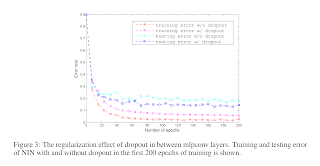NIN(三):Illustrated
2021/03/07
-----
https://pixabay.com/zh/photos/drop-splash-drip-water-liquid-wet-3698073/
-----
Figure 1: Comparison of linear convolution layer and mlpconv layer. The linear convolution layer includes a linear filter while the mlpconv layer includes a micro network (we choose the multilayer perceptron in this paper). Both layers map the local receptive field to a confidence value of the latent concept.
圖1:線性卷積層和 mlpconv 層的比較。 線性卷積層包括一個線性濾波器,而mlpconv層包括一個微網路(我們在本文中選擇多層感知器)。 兩層都將局部感受野映射到「潛在概念的置信度值」。
# NIN
說明:
這只能算是一個示意圖。左邊是一般卷積。右邊是一般卷積再通過 Conv1,也就是 1 x 1 convolution。Conv1 可以將多張特徵圖升維或降維。
-----
Figure 2: The overall structure of Network In Network. In this paper the NINs include the stacking of three mlpconv layers and one global average pooling layer.
圖2:“網路中的網路”的整體結構。 在本論文中,NIN 包括三個 mlpconv 層和一個全局平均池化層的堆疊。
# NIN
說明:
Conv1 後來通常用來用於升維與降維。但原論文中,只是用來重新調整特徵圖像素的值。可以與 AlexNet 的 LRN 比較。由學習權重而調整像素值理論上比專家的設定公式更好。
-----
3.3 Local Response Normalization
# AlexNet
說明:
是一個過時的專家方法。在 GoogLeNet 裡面認為有用,在 VGGNet 裡面認為沒用。實際上 Conv1 更一般化且結果更好。
-----
Table 1: Test set error rates for CIFAR-10 of various methods.
# NIN
說明:
NIN 加上 Dropout 與資料擴增兩種正則化方法(避免過擬合)明顯優於當時其他演算法在 CIFAR10 上的表現。
-----
Figure 3: The regularization effect of dropout in between mlpconv layers. Training and testing error of NIN with and without dropout in the first 200 epochs of training is shown.
圖3:mlpconv 層之間,dropout 的正則化效果。 顯示了在訓練的前 200 個時期中有無 dropout 的 NIN 的訓練和測試錯誤。
# NIN
說明:
Dropout 是一個正則化工具。Conv1「應該」也是一個正則化的工具。論文提到全局平均池化也是一個正則化工具。總之,「平均」避免了過度針對個別像素而建立模型,也就是避免了過擬合。
-----
Table 2: Test set error rates for CIFAR-100 of various methods.
說明:
NIN 搭配 Dropout 是基本組合。
-----
Table 3: Test set error rates for SVHN of various methods.
# NIN
說明:
SVHN 的場景下,DropConnect 優於 Dropout + NIN。
-----
Table 4: Test set error rates for MNIST of various methods.
# NIN
說明:
在經典的 MNIST 上,大部分都調到很低的錯誤率了。
-----
Table 5: Global average pooling compared to fully connected layer.
# NIN
說明:
GAP 看起來比 Dropout 的正則化效果更好。
-----
說明:
GAP 雖然可以避免過擬合,但是不利遷移學習,因為影像的特徵要重新學習。在原先有全連接層的狀態下,影像特徵可以大部分保留,主要重新訓練全連接層即可。
https://zhuanlan.zhihu.com/p/46235425
-----
◎ 正則化:減少參數量、避免過擬合。
以下是幾種正則化:
L2:增加一個平方項(單位圓)的懲罰項,讓結果不要太好(過擬合)。
Weight Decay:參數的值在訓練時以一定的比例衰減,部分參數就會趨近於 0。(L2 在 SGD 等同 WD。)
Dropout:(全連接層的參數太多)以 p 的比例每次訓練隨機丟棄神經元。推論時權重再乘以 p。(Dropout 是一種 Ensemble Learning,也就是多個子模型的平均。)
全局平均池化:直接放棄全連接層,參數因而大量減少。
-----
Figure 4: Visualization of the feature maps from the last mlpconv layer. Only top 10% activations in the feature maps are shown. The categories corresponding to the feature maps are: 1. airplane, 2. automobile, 3. bird, 4. cat, 5. deer, 6. dog, 7. frog, 8. horse, 9. ship, 10. truck. Feature maps corresponding to the ground truth of the input images are highlighted. The left panel and right panel are just different examplars.
圖4:可視化來自最後一個 mlpconv 層的特徵圖。 僅顯示功能圖中激活率最高的 10%。 與特徵圖相對應的類別為:1。飛機,2。汽車,3。鳥,4。貓,5。鹿,6。狗,7。青蛙,8。馬,9。船,10。卡車。 與輸入圖像的真值相對應的特徵圖被凸顯。 左面板和右面板只是不同的示例。
說明:
可以特別注意一下汽車。
-----
Figure 1: A Squeeze-and-Excitation block.
# SENet
說明:
SENet 模組透過訓練,調整通道間每張特徵圖像素值的 scale。
-----
Figure 2: The schema of the original Inception module (left) and the SE-Inception module (right).
圖2:原始 Inception 模塊(左)和 SE-Inception 模塊(右)的架構。
# SENet
說明:
先經過全局平均池化將每張特徵圖縮成一個點。接下來將通道數 C 個點透過全連接層轉成 C / r 個點。ReLU。透過全連接層再轉回 C 個點。Sigmoid,得到每張特徵圖的 scale 係數。係數乘以原特徵圖。內層選 ReLU,因為 ReLU 就很好用了。外層選 sigmoid,因為要讓 scale 的值在 0 跟 1 之間。
-----
Figure 3: The schema of the original Residual module (left) and the SE-ResNet module (right).
圖3:原始殘差模塊(左)和 SE-ResNet 模塊(右)的架構。
# SENet
說明:
參考圖2。
-----
Figure 1. Selective Kernel Convolution.
# SKNet
說明:
一開始是 Conv3(dilation size = 2)跟 Conv5,黃綠兩個 U,點對點相加。到 z 為止,跟 SENet 類似。分別對 a 跟 b 兩個向量做 softmax 後,得到 ac 跟 bc 兩個係數,c 代表第 c 張特徵圖。由於 softmax 的特性,ac + bc = 1。ac 跟 bc 決定 Conv3 跟 Conv5 兩種特徵圖的比例。輸出為 V。
-----
# SKNet
說明:
d = max(C/r, L)。L = 32 是論文設定。d 是壓縮後的一維矩陣的長度。
z = Ffc(s) = δ(B(Ws))。B 是 Batch Normalization。δ 是 ReLU。
精神上還是跟 SENet 一樣,只是由一個向量變成兩個向量。兩個向量會再經過 softmax。
-----
# SKNet
說明:
C:channel 數。
c:channel index。
-----
# SKNet
說明:
新的 V 每張特徵圖由 Conv3 跟 Conv5 組成,比例由先前的 softmax 形成。
-----
References
# LRN vs Conv1
# AlexNet
Krizhevsky, Alex, Ilya Sutskever, and Geoffrey E. Hinton. "Imagenet classification with deep convolutional neural networks." Advances in neural information processing systems 25 (2012): 1097-1105.
https://proceedings.neurips.cc/paper/2012/file/c399862d3b9d6b76c8436e924a68c45b-Paper.pdf
# channel domain
# NIN。
Lin, Min, Qiang Chen, and Shuicheng Yan. "Network in network." arXiv preprint arXiv:1312.4400 (2013).
https://arxiv.org/pdf/1312.4400.pdf
# # SENet
Hu, Jie, Li Shen, and Gang Sun. "Squeeze-and-excitation networks." Proceedings of the IEEE conference on computer vision and pattern recognition. 2018.
# SKNet
Li, Xiang, et al. "Selective kernel networks." Proceedings of the IEEE conference on computer vision and pattern recognition. 2019.
-----



















No comments:
Post a Comment